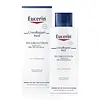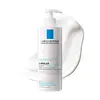What's inside
What's inside
 Key Ingredients
Key Ingredients

 Benefits
Benefits

 Concerns
Concerns

 Ingredients Side-by-side
Ingredients Side-by-side

Water
Skin ConditioningUrea
BufferingGlycerin
HumectantIsopropyl Stearate
EmollientDicaprylyl Ether
EmollientGlyceryl Glucoside
HumectantSodium Lactate
BufferingButyrospermum Parkii Butter
Skin ConditioningTapioca Starch
Polyglyceryl-4 Diisostearate/Polyhydroxystearate/Sebacate
EmulsifyingCarnitine
CleansingCetearyl Alcohol
EmollientCeramide NP
Skin ConditioningArginine Hcl
Skin ConditioningSodium PCA
HumectantHistidine
HumectantAlanine
MaskingCitrulline
Skin ConditioningLysine
Skin ConditioningSerine
MaskingLactic Acid
BufferingSodium Chloride
MaskingMannitol
HumectantSucrose
HumectantGlutamic Acid
HumectantThreonine
Glycogen
Humectant1,2-Hexanediol
Skin ConditioningPhenoxyethanol
PreservativePotassium Sorbate
PreservativeArginine
MaskingPCA
HumectantWater, Urea, Glycerin, Isopropyl Stearate, Dicaprylyl Ether, Glyceryl Glucoside, Sodium Lactate, Butyrospermum Parkii Butter, Tapioca Starch, Polyglyceryl-4 Diisostearate/Polyhydroxystearate/Sebacate, Carnitine, Cetearyl Alcohol, Ceramide NP, Arginine Hcl, Sodium PCA, Histidine, Alanine, Citrulline, Lysine, Serine, Lactic Acid, Sodium Chloride, Mannitol, Sucrose, Glutamic Acid, Threonine, Glycogen, 1,2-Hexanediol, Phenoxyethanol, Potassium Sorbate, Arginine, PCA
Water
Skin ConditioningButyrospermum Parkii Butter
Skin ConditioningGlycerin
HumectantDimethicone
EmollientUrea
BufferingParaffinum Liquidum
EmollientSodium Lactate
BufferingCetearyl Alcohol
EmollientPEG-100 Stearate
Glyceryl Stearate
EmollientPropylene Glycol
HumectantGlycine
BufferingStearic Acid
CleansingDimethiconol
EmollientSodium Hydroxide
BufferingPalmitic Acid
EmollientDisodium EDTA
Hydroxyethylpiperazine Ethane Sulfonic Acid
BufferingXanthan Gum
EmulsifyingAcrylates/C10-30 Alkyl Acrylate Crosspolymer
Emulsion StabilisingTocopherol
AntioxidantPhenoxyethanol
PreservativeChlorhexidine Digluconate
AntimicrobialParfum
MaskingWater, Butyrospermum Parkii Butter, Glycerin, Dimethicone, Urea, Paraffinum Liquidum, Sodium Lactate, Cetearyl Alcohol, PEG-100 Stearate, Glyceryl Stearate, Propylene Glycol, Glycine, Stearic Acid, Dimethiconol, Sodium Hydroxide, Palmitic Acid, Disodium EDTA, Hydroxyethylpiperazine Ethane Sulfonic Acid, Xanthan Gum, Acrylates/C10-30 Alkyl Acrylate Crosspolymer, Tocopherol, Phenoxyethanol, Chlorhexidine Digluconate, Parfum
 Reviews
Reviews

Ingredients Explained
These ingredients are found in both products.
Ingredients higher up in an ingredient list are typically present in a larger amount.
This ingredient is also known as shea butter. It is an effective skin hydrator and emollient.
Emollients help soothe and soften your skin. It does this by creating a protective film on your skin. This barrier helps trap moisture and keeps your skin hydrated. Emollients may be effective at treating dry or itchy skin.
Shea butter is rich in antioxidants. Antioxidants help fight free-radicals, or molecules that may harm the body. It is also full of fatty acids including stearic acid and linoleic acid. These acids help replenish the skin and keep skin moisturized.
While Shea Butter has an SPF rating of about 3-4, it is not a sunscreen replacement.
Shea butter may not be fungal acne safe. We recommend speaking with a professional if you have any concerns.
Learn more about Butyrospermum Parkii ButterCetearyl alcohol is a mixture of two fatty alcohols: cetyl alcohol and stearyl alcohol. It is mainly used as an emulsifier. Emulsifiers help prevent the separation of oils and products. Due to its composition, it can also be used to thicken a product or help create foam.
Cetearyl alcohol is an emollient. Emollients help soothe and hydrate the skin by trapping moisture.
Studies show Cetearyl alcohol is non-toxic and non-irritating. The FDA allows products labeled "alcohol-free" to have fatty alcohols.
This ingredient is usually derived from plant oils such as palm, vegetable, or coconut oils. There is debate on whether this ingredient will cause acne.
Due to the fatty acid base, this ingredient may not be Malassezia folliculitis safe.
Learn more about Cetearyl AlcoholGlycerin is already naturally found in your skin. It helps moisturize and protect your skin.
A study from 2016 found glycerin to be more effective as a humectant than AHAs and hyaluronic acid.
As a humectant, it helps the skin stay hydrated by pulling moisture to your skin. The low molecular weight of glycerin allows it to pull moisture into the deeper layers of your skin.
Hydrated skin improves your skin barrier; Your skin barrier helps protect against irritants and bacteria.
Glycerin has also been found to have antimicrobial and antiviral properties. Due to these properties, glycerin is often used in wound and burn treatments.
In cosmetics, glycerin is usually derived from plants such as soybean or palm. However, it can also be sourced from animals, such as tallow or animal fat.
This ingredient is organic, colorless, odorless, and non-toxic.
Glycerin is the name for this ingredient in American English. British English uses Glycerol/Glycerine.
Learn more about GlycerinPhenoxyethanol is a preservative that has germicide, antimicrobial, and aromatic properties. Studies show that phenoxyethanol can prevent microbial growth. By itself, it has a scent that is similar to that of a rose.
It's often used in formulations along with Caprylyl Glycol to preserve the shelf life of products.
Sodium Lactate is the sodium salt of lactic acid, an AHA. It is a humectant and sometimes used to adjust the pH of a product.
This ingredient is part of our skin's NMF, or natural moisturizing factor. Our NMF is essential for the hydration of our top skin layers and plasticity of skin. NMF also influences our skin's natural acid mantle and pH, which protects our skin from harmful bacteria.
High percentages of Sodium Lactate can have an exfoliating effect.
Fun fact: Sodium Lactate is produced from fermented sugar.
Learn more about Sodium LactateUrea is also called carbamide and is the diamide of carbonic acid. In cosmetics, urea is used to hydrate the skin. It also provides exfoliation in higher concentrations.
As a humectant, urea helps draw moisture from the air and from deep within the skin. This helps hydrate your skin. Studies show urea is an effective moisturizer for dry skin conditions. 40% urea is typical in medications for treating eczema and other skin conditions.
Urea has the strongest exfoliation effect in concentrations higher than 10%. It is a keratolytic agent, meaning it breaks down the keratin protein in the top layer of skin. This helps remove dead skin cells and flaking skin.
In medicine, urea has been shown to help increase the potency of other ingredients, such as fungal treatments.
Humans and animals use urea to metabolize nitrogen-containing compounds. Urea is highly soluble in water. Once dissolved, it is neither acidic nor alkaline.
Learn more about UreaWater. It's the most common cosmetic ingredient of all. You'll usually see it at the top of ingredient lists, meaning that it makes up the largest part of the product.
So why is it so popular? Water most often acts as a solvent - this means that it helps dissolve other ingredients into the formulation.
You'll also recognize water as that liquid we all need to stay alive. If you see this, drink a glass of water. Stay hydrated!
Learn more about Water